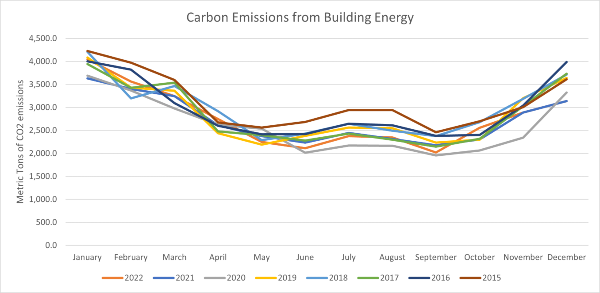Water and Energy Use


Just from building energy consumption, the county has reduced our carbon emissions by 4,082 metric tons, almost an 11% decrease since 2015.
Allegheny County strives for efficient and responsible energy and water consumption.
Allegheny County tracks utility consumption in all county facilities, using 2015 as our baseline. This includes tracking of electricity, natural gas, steam, and water consumption, as well as wastewater and stormwater fees. Though many organizations saw an impact in utilities from COVID, much of the county’s reductions and savings over the years can be attributed to efficiency upgrades such as LED lighting, energy efficient equipment, the new steam boiler plants that generate steam heat and hot water for our downtown buildings, and more.
The county parks host several water features including three wave pools, the North Park pool, and two spray parks. These consume a large amount of water; therefore, efficiency is important to balance the cost and environmental impacts. In Park facilities with flush toilets and sinks, Allegheny County has installed low flow toilets and auto shut off faucets. The county also works to detect and fix any leaks in our pools and spray parks to reduce water loss throughout the season. Since 2015, our park facilities have reduced water consumption by almost 9 million gallons.
Allegheny County is also a founding member of the Pittsburgh 2030 District with goals of 50% reduction in building energy and water, as well as commuter transportation, by the year 2030. Learn more about the 2030 Districts energy and water reduction efforts.
Commercial Property Assessed Clean Energy program (C-PACE) finances energy efficiency and renewable energy improvements on private property. It has invested over $11.95 million in renewable energy and energy efficiency projects which will save $456,000 in annual energy costs and 3,990 metric tons of CO2: equivalent to 503 homes’ energy use for one year.
Green Parking Lot
A 2.5-acre water-permeable green parking lot was installed in South Park, accommodating 125 vehicles, including five ADA-accessible spaces. This lot is designed to capture 95% of all rain that falls on it, diverting about 2.5 million gallons of stormwater from local waterways each year.
The oils, heavy metals, and sediment that would otherwise enter Catfish Run will be cleaned and cooled by soil and stone using permeable pavers and two rain gardens. Rainwater will infiltrate gravel recharge beds beneath, while the rain gardens provide green space with native plant species to further filter and slow down the stormwater. Surrounding trees will shade the lot which helps to reduce the heat around the fairgrounds and improve air quality.
Renewable Energy Investment
Solar Pedestrian Lights
The Parks Department completed several solar lighting projects that increase pedestrian safety in both South Park and North Park. Solar powered crosswalk beacons were added to high pedestrian trafficked crosswalks at the Boathouse and near the Deck Hockey Court in North Park, and near the Ice Rink, Round Barn, and the Black and Gold Playground in South Park. Solar path lights were installed along trails in North Park along Tennis Court Road, and in South Park along Maple Springs Road, about a half mile in each park. These allow visitors to exercise in the evening, especially in the winter when the sun sets early.
Two miles of a popular pedestrian path along Corrigan Drive in South Park, between Library and Brownsville Road are now lit with 122 solar lights. The LED bulbs being used are about 50 percent more energy efficient than the typical bulb used for street/path lights. By using solar energy instead of electricity to power the lights, the county will annually prevent 20,194 pounds of carbon dioxide, 16 pounds of sulfur dioxide, and 14 pounds of nitrogen oxide from being emitted by power plants while also saving $13,000 in electricity costs over the next decade. The project also included the installation of 25 educational signs along the path that provides information related to air quality and what the public can do to help reduce air pollution.
Solar Park Shelters
Solar panels were installed on park shelters, one at eight of our parks. These provide sustainable power in areas where tying to the electrical grid would be costly and inconvenient. This enables visitors to power items needed for parties like speakers, crock pots, and phone chargers.
Net Zero Parks
Allegheny County broke ground on our Net Zero Parks projects in December 2022. These are solar photovoltaic arrays being installed in Deer Lakes and White Oak parks which will produce enough energy to offset the energy consumed in both parks. Total electricity anticipated to be generated between the systems is kWh, and both parks will be applying for Net Zero Certification through the International Living Future Institute (ILFI).
Renewable Energy Credits
On January 28, 2021, County Executive Rich Fitzgerald announced that the county has entered into a power purchase agreement with Rye Development to purchase 7.4 MW of renewable electricity from a new low-impact, run-of-river hydroelectric facility to be located on the Ohio River. The 35-year agreement and financial investment makes possible the development and financing of new renewable energy capacity right in the county.
Currently, Allegheny County uses approximately 50,000 MWh of electricity a year for its buildings and operations. Most of its energy is purchased through a consortium of buyers which shifted in 2021 to making its energy purchases from 100% renewable sources, although many of those sources are not local.
The energy purchased by this agreement and its associated Renewable Energy Credits (RECs) will cover over 90% of the county’s annual load with Renewable Energy Credits (RECs). Combined with the county’s continued enhanced energy efficiency measures, it won’t be long before the county will achieve its goal for 100% renewable energy through local sources.
Allegheny County Hydropower Project